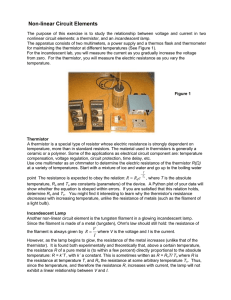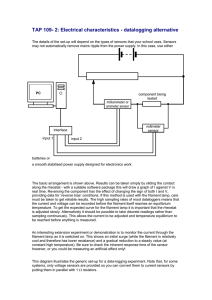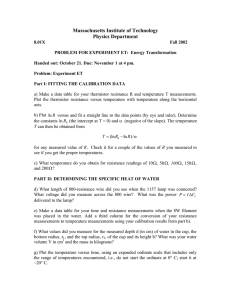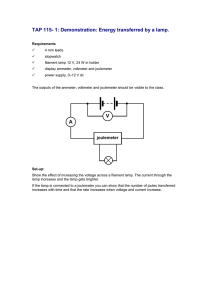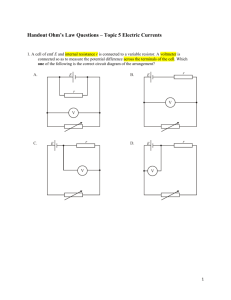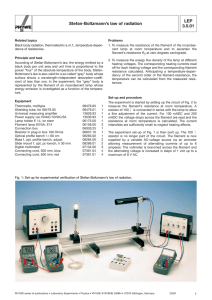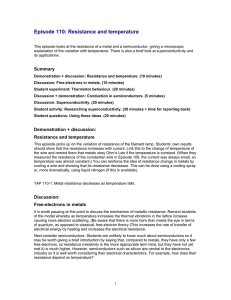THERMISTORS AND DIODES
advertisement
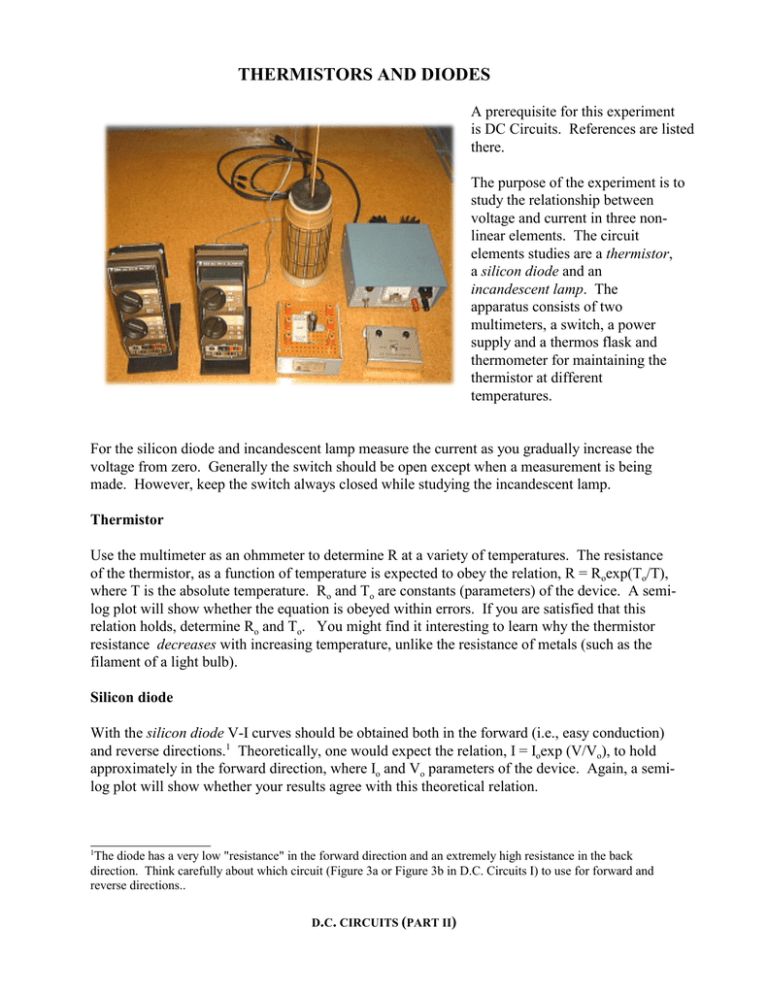
THERMISTORS AND DIODES A prerequisite for this experiment is DC Circuits. References are listed there. The purpose of the experiment is to study the relationship between voltage and current in three nonlinear elements. The circuit elements studies are a thermistor, a silicon diode and an incandescent lamp. The apparatus consists of two multimeters, a switch, a power supply and a thermos flask and thermometer for maintaining the thermistor at different temperatures. For the silicon diode and incandescent lamp measure the current as you gradually increase the voltage from zero. Generally the switch should be open except when a measurement is being made. However, keep the switch always closed while studying the incandescent lamp. Thermistor Use the multimeter as an ohmmeter to determine R at a variety of temperatures. The resistance of the thermistor, as a function of temperature is expected to obey the relation, R = Roexp(To/T), where T is the absolute temperature. Ro and To are constants (parameters) of the device. A semilog plot will show whether the equation is obeyed within errors. If you are satisfied that this relation holds, determine Ro and To. You might find it interesting to learn why the thermistor resistance decreases with increasing temperature, unlike the resistance of metals (such as the filament of a light bulb). Silicon diode With the silicon diode V-I curves should be obtained both in the forward (i.e., easy conduction) and reverse directions.1 Theoretically, one would expect the relation, I = Ioexp (V/Vo), to hold approximately in the forward direction, where Io and Vo parameters of the device. Again, a semilog plot will show whether your results agree with this theoretical relation. 1 The diode has a very low "resistance" in the forward direction and an extremely high resistance in the back direction. Think carefully about which circuit (Figure 3a or Figure 3b in D.C. Circuits I) to use for forward and reverse directions.. D.C. CIRCUITS (PART II) Incandescent Lamp Another non-linear circuit element is the tungsten filament in a glowing incadescent lamp. Since the filament is made of the metal tungsten, Ohm's law should still hold; i.e. the resistance of the filament is always given by R = V/I. However, as the lamp begins to glow, the resistance of the metal increases (unlike that of the thermistor). It is found both experimentally and theoretically that, above a certain temperature, the resistance R of a pure metal is, to within a few percent, directly proportional to the absolute temperature, i.e., R = k´T , with k´ a constant (this is sometimes written as R = RoT/ To where R is the resistance at temperature T, and Ro the resistance at some arbitrary temperature To ). Thus, since the temperature, and therefore the resistance R, increases with current, the lamp will not exhibit a linear relationship between V and I. (A) Investigate the actual relationship between V and I for the lamp by increasing the voltage gradually in steps without opening the switch between readings. The readings should be taken across a full range of voltage up to 25 volts or so. Take several readings at low voltages (< 1 V) and currents (< 3mA) and also at high voltages (>20V). Plot your results on a log-log graph to see if they satisfy the relation, V = kIa where V is the voltage; I, the current; and k and a are constants. If this formula holds, determine k and a. (B) How is the heat that you feel radiating from a hot body related to the temperature of the body? The answer to this question was given by two physicists whose names are now associated with the famous Stefan-Boltzmann law - the power" radiated from unit area of any body at an absolute temperature T is given by " = ) Tn where ) and n are universal constants (i.e. the same for all radiating bodies) and is a constant that depends on the particular radiating body. ) is called the Stefan-Boltzmann constant, and is called the emissivity of the radiating body, with a value between 0 and 1. (What is your guess for the value of n?). The voltage-current data you have gathered can now be used to determine the value of n. We make the not unreasonable assumption that that when the filament reaches thermal equilibrium at higher temperatures, the electrical power fed into the lamp, VI, is almost entirely dissipated in the form of radiation, Q emitted from the filament; i.e Q = VI. Q is just " multiplied by the area of the filament. Using the relation between V and I that you determined above, Q can be then written as a function of I (and constants). Similarly, T can be expressed as a function of R, which, being equal to V/I, can also be expressed as a function of I (and constants). Eliminating I from these expressions for Q and for R yields the required relationship between the two; by inspection a value of n in terms of a can be extracted. Check the References to see if your value agrees with that of Stefan and Boltzmann! (dh - 1983, jbv- 1988, tk-1998) 2 See for example, Halliday and Resnick, Physics, of the "Stefan-Boltzmann Law" experiment. D.C. CIRCUITS (PART II)
